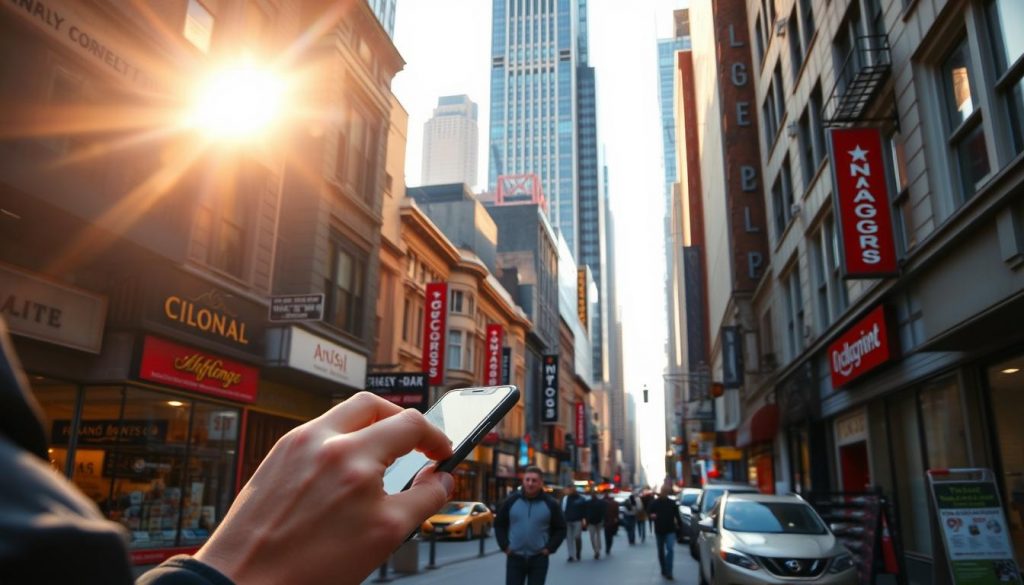We offer a practical, data-driven path to hyper-local content marketing that matches how people search today.
Nearby searches now include implied location. Google shows fewer, higher-quality local results and more SERP features like “Discover more places.” That shift gives you an edge when you serve the right audience within walking distance.
In this guide we explain who benefits most: any business with a physical location or service area that wants more in-store visits and close-by leads. You will learn how to structure pages, craft neighborhood-first stories, and run offers and media that bring people through your door.
We focus on measurable wins: accurate profiles, trusted reviews, useful assets, and conversion-focused experiences that drive visits and revenue. This is a step-by-step playbook you can use this week to protect your brand and grow awareness.
Key Takeaways
- Practical playbook: Step-by-step tactics you can apply quickly to boost foot traffic.
- Audience-first: Target people near your location with relevant offers and media.
- Measure impact: Track calls, visits, and revenue to link activity to results.
- Balance channels: Combine organic presence and paid media to cover search to store paths.
- Long-term brand: Use proximity and relevance to build lasting awareness and trust.
Why Hyper-Local Matters in 2025: Intent, Mobile, and “Near Me” Behaviors
Search behavior has shifted: people now expect engines to know where they are and show nearby options automatically. In the mid-2010s “near me” queries surged, then plain local searches grew 150% faster. That shows users rely on implied location when they search.
From “near me” to implicit intent
From “near me” to implicit location intent in search results
Mobile use pushed this change. Phones demand fast answers about what’s close, open, and worth your time. Google updated Maps and added modules like “Discover more places,” so high-quality local results rank higher in search results.

ROPO and the rise of foot traffic as a core KPI
ROPO — research online, purchase offline — still drives outcomes. We measure phone calls, direction clicks, store visits, and foot traffic alongside online conversions. These metrics connect digital activity to real-world results.
- Optimize your Google Business Profile so you appear for searches without geo-words.
- Prioritize speed-to-answer: hours, inventory cues, and clear CTAs reduce decision time.
- Track visits and calls as primary indicators of local success, not just clicks.
Hyper-Local vs Local: Defining the Radius, the Audience, and the Strategy
Scale matters: reach national audiences or zoom into a single block — each choice changes tactics and KPIs.
We map the granularity spectrum for clarity. National marketing builds reach across the country. Regional layers add cultural and seasonal nuance. Local works at DMA, city, or ZIP scale. At the smallest end, campaigns focus on blocks, buildings, and households.

Radius in practice: use several miles for reach; drop to one mile or less when density and store proximity support it. That tight radius lets you align offers to a real-world travel pattern.
Audience tightening: device and household targeting lets you match messages to micro-areas. Expect many small campaigns running in parallel, each with clear objectives and tailored creative.
- Operational note: standardize templates, but localize copy and images by distance and traffic flows.
- Media and advertising shift from branding to neighborhood value propositions.
- Measurement: prioritize store visit estimates, call tracking, and local conversion actions to validate each campaign.
For businesses with multiple locations, pick initial footprints by demand density, competitor clusters, and nearby complementary stores. When one micro-area performs, replicate the setup to adjacent locations with localized creative and budget adjustments.
The Signals That Move the Needle in Hyper-Local Search
Local ranking hinges on a few measurable signals that you can control. We focus on practical items that improve visibility and visits. A clear, accurate profile and steady reviews drive measurable lifts in clicks and directions.
Google Business Profile completeness, categories, and consistency
A complete Google Business profile powers Maps and local panels. Include primary and secondary categories, exact NAP, hours (add holidays), photos, and attributes. Add menus or reservation links to reduce friction and help customers act.
Reviews as ranking and conversion signals
Reviews influence Local Pack ranking and serve as social proof. Ask consistently, respond to feedback, and surface ratings on local pages and ads. A simple review plan lifts both visibility and conversion rates.
Proximity, distance, and expected travel time considerations
Search engines weigh distance and expected travel time. Clusters of similar businesses change pack dynamics; strong profile data and ongoing updates help you win within a dense area.
| Signal | Action | Impact |
|---|---|---|
| Profile completeness | Fill categories, hours, photos, integrations | Higher placement in Maps and panels |
| Reviews | Request, respond, feature ratings | More clicks and trust from nearby searchers |
| Proximity & accuracy | Verify coordinates, remove duplicates | Better discovery and fewer lost leads |
Measure calls, direction requests, and website taps after updates. That data shows what improves visits and supports ongoing local marketing efforts.
hyper-local content marketing: Building Neighborhood-First Content That Converts
Local landing pages act like digital signposts for nearby customers. They answer the simple questions people ask: where, when, and what you offer. Done right, these pages improve discovery in search and lift conversions.
Local landing pages by area, neighborhoods, and locations
We recommend a unique page for each neighborhood you serve. Include clear hours, address, map embed, and service specifics for those locations.
Use landmarks and cross-streets to orient customers. This reduces decision friction and increases direction clicks.
Storytelling: events, community highlights, products services fit
Tie your products and services to local events, seasonal needs, and community stories. Feature nearby businesses and causes to strengthen your brand’s local bond.
Media mix: short-form video, UGC, and geotagged posts
Define a simple media system: short videos, customer UGC highlights, and geotagged posts. These assets boost profile updates and social discovery.
“Creating pages per site — with hours, menus, and directions — drives both discovery and ad relevance.”
- Pages feed paid ads and improve Quality Score.
- Use schema, FAQs, and social proof to answer objections.
- Capture emails and SMS opt-ins with neighborhood offers.
| Element | What to include | Benefit |
|---|---|---|
| Landing page | Hours, map, phone, landmark | Higher discovery and direction clicks |
| Local storytelling | Events, partner features, seasonal notes | Stronger local trust and relevance |
| Media system | Short video, UGC, geotags | More engagement and repeat visits |
| Email/SMS | Neighborhood offers, opt-ins | Faster response and higher return visits |
Measure page-level calls and direction clicks. Then publish, promote via media, and iterate by area to grow local business results.
On-Page Hyper-Local SEO: Keywords, Structure, and Schema
On-page signals let search engines map your business to the exact streets people use in queries.
We start with intent: research search queries that include street names, landmarks, and micro-areas. Group those queries by page so each page answers a tight set of local questions.
One primary term per location page works best. Add semantically related phrases to support the main term. This tight approach mirrors single-keyword ad group logic and improves clarity and visibility.
Structure, links, and NAP
Build a hub page that links to neighborhood pages. Cross-link adjacent locations with descriptive anchors like “Parkside hours” or “Main St services.”
Enforce exact NAP across the site and your Google Business profile. Mismatches confuse engines and harm trust.
Schema and media
Implement structured data: LocalBusiness, Product, and Review markup. This helps engines parse your data and can boost how pages appear in search results.
Add localized FAQs about parking, transit, and hours. Optimize images with geotag context and alt text that reference the neighborhood.
Measure impressions and clicks for each page’s target terms. Use those data to iterate and scale the approach with template pages, then customize copy, media, and offers by area.
Driving Foot Traffic with Google Ads Radius Targeting
Tight radius targeting in Google Ads turns nearby interest into measurable store visits. We set campaigns to focus budget where convenience and intent align.
Campaign setup: locations, radius, and advanced geolocation controls
Set geolocation under Campaigns > Settings > Locations > Advanced search. Choose Radius targeting and define a small area — one mile or one kilometer — around your store.
Test tighter distances to see where clicks turn into calls and visits. Exclude zip codes or neighborhoods outside your footprint with negative locations.
Keyword strategy: “near me”, neighborhood modifiers, and negatives
Build neighborhood keyword sets: “near me,” cross-streets, landmarks, and local nicknames. Use negatives to filter searches that fall outside your radius.
Single-theme ad groups improve relevance and Quality Score. Call out distance, pickup time, or directions in the ad copy.
Extensions, CTAs, and measurement with conversion tracking
Enable location, call, and sitelink extensions to shorten the path to visit. Schedule ads for peak hours and align offers to busy times.
- Bid by proximity: higher bids nearest your location, lower as travel time grows.
- Track conversions: Tag Manager for calls, form fills, and direction clicks.
- Review weekly: reallocate budget to radius segments that drive the best foot traffic and calls.
Winning on Meta: Local Awareness Ads, Store Visits, and Local Insights
Meta’s local tools let us target real-world people close to your store with precise, time-based ads. We use Local Awareness or Store Visits objectives to anchor campaigns around an address and a tight radius. Local Insights adds context: busiest days, peak hours, and how many people were nearby.
Creative must match who is nearby and when. Morning commuters need quick offers and directions. Residents respond to community deals and evening promos. Families use weekend bundles. We swap images and copy to reflect neighborhood landmarks and tone.
Audience and traveler vs resident targeting
Separate messages for travelers and residents. Travelers value speed and convenience. Residents care about trust and repeat value. We set age and gender where it helps and test short video and UGC-style media to increase engagement.
Using Local Insights to optimize campaigns
Local Insights is anonymized but actionable. It shows peak times and reach within your radius. Note: radius limits and ZIP polygon targeting behave differently across locations and countries. We watch frequency caps in small audiences to avoid fatigue and iterate weekly on radius, budget, and placements for the best results.
- Action: Run Local Awareness/Store Visits objectives.
- Test: short video, UGC, and time-sliced creative.
- Measure: store visits, direction clicks, and calls.
Community-Driven Local Marketing: Organic Social, Partnerships, and Offline
Neighborhood trust often determines whether people walk through your door. We blend organic social activity, partner promotions, and street-level programs to build that trust and drive visits.
Location tags, local hashtags, and micro-influencer collaboration
We plan a steady organic cadence using location tags and neighborhood hashtags to show up in local feeds and stories. Short posts and frequent updates keep your account relevant and discoverable.
Identify micro-influencers and community pages residents trust. Co-create simple videos or limited-time offers with them. Those partnerships amplify reach and add social proof in the exact area you serve.
Offline activations: events, print, and neighborhood co-promotions
Offline tactics extend digital work into real life. Host or sponsor neighborhood events, partner with adjacent businesses, and distribute flyers along busy corridors.
Use posters, QR codes to local landing pages, and co-promotions that bundle services for a shared audience. Capture opt-ins at each activation so you can follow up with email or SMS.
- Plan: regular tags and hashtags to appear in local feeds.
- Partner: work with micro-influencers and trusted community pages.
- Activate: events, posters, flyers, and QR-driven offers.
- Measure: track redemptions, calls, and walk-ins after each campaign.
Document every activation with photos and short clips. Repurpose that media across channels to extend awareness and keep your brand top of mind in the neighborhood.
Reputation, Reviews, and Referrals: Turning Customers into Advocates
Turning satisfied customers into advocates starts with a repeatable, respectful outreach plan. Reviews significantly influence Local Pack rankings and conversions. We treat them as a core growth lever for businesses.
Systematizing SMS/email review requests and response playbooks
We design a compliant SMS/email sequence that asks every customer for a review at the right time. Messages include a clear link to the preferred platform and a short personalization token.
Response playbooks guide replies. Thank positive reviewers. Address negatives with empathy and offer a resolution quickly. This protects brand reputation and shows accountability.
Leveraging ratings in ads, landing pages, and Google Business
Featuring ratings in ads and on neighborhood landing pages improves click-through and trust. Keep your Google Business Profile fresh with new photos and timely Q&A responses.
“Quick, human replies turn problems into proof points.”
- Integrate referrals after a review to fuel low-cost growth.
- Track star trends, review velocity, and correlation to calls, visits, and sales.
- Train staff to request feedback in person and maintain brand voice in every reply.
| Action | Why it matters | Primary metric |
|---|---|---|
| Automated SMS/email | Increases review volume and velocity | New reviews / month |
| Response playbook | Protects reputation and reduces escalation | Response time & sentiment |
| Ratings in ads & pages | Boosts CTR and trust | CTR and conversion rate |
| Referral prompt | Turns reviews into low-cost leads | Referrals / conversions |
Tools, Data, and Compliance: Running a Scalable Hyper-Local Program
Scaling local efforts starts with reliable tools, clear data, and firm governance. We design a stack that ties visibility to visits. That way leaders see real impact beyond clicks.
Dashboards and KPIs: visibility, traffic, sales, and foot metrics
We track store visits, calls, direction requests, and online conversions alongside visibility KPIs. These metrics show if a campaign drives real revenue.
We define few, powerful KPIs: visibility lift, calls, direction clicks, visits, and revenue. Dashboards segment by micro-area so you can invest where results are strongest.
AI for content, ads, and operations — with brand and legal compliance
AI drafts local text and ads, automates repetitive tasks, and suggests optimizations. We lock templates so every output meets brand and legal rules.
Marketing funds, platforms, and templates for repeatable campaigns
Local platforms centralize assets, templates, funds, and analytics. Partner funds (co-op/MDF) reduce net spend when program rules are followed. Governance defines approvers, audit cadence, and documentation.
| Focus | What we track | Why it matters |
|---|---|---|
| Visibility | Impressions, local rank | Shows discovery reach |
| Foot traffic | Store visits, direction clicks | Connects digital to in-store revenue |
| Operations | Templates, approvals, fund usage | Keeps brand safe and spend efficient |
Conclusion
A tight, data-led local approach converts discovery into real-world sales.
We recap the playbook: align your online presence to how people search nearby, then turn discovery into measurable foot traffic and sales.
Start with the basics: accurate profiles, consistent NAP, and fresh reviews to lift visibility in search results and build trust with people in your area.
Use focused google ads with the right radius and Meta insights to cut waste. Pair ads with neighborhood landing pages and clear products services stories that match relevant keywords and search queries.
Test offers, schedules, and radius, and measure calls, direction clicks, traffic, and sales. Audit one location this week, run a tight ad test, and report weekly on results.
Iterate fast, scale wins across nearby areas, and keep the strategy simple—start with one neighborhood and build from there.


